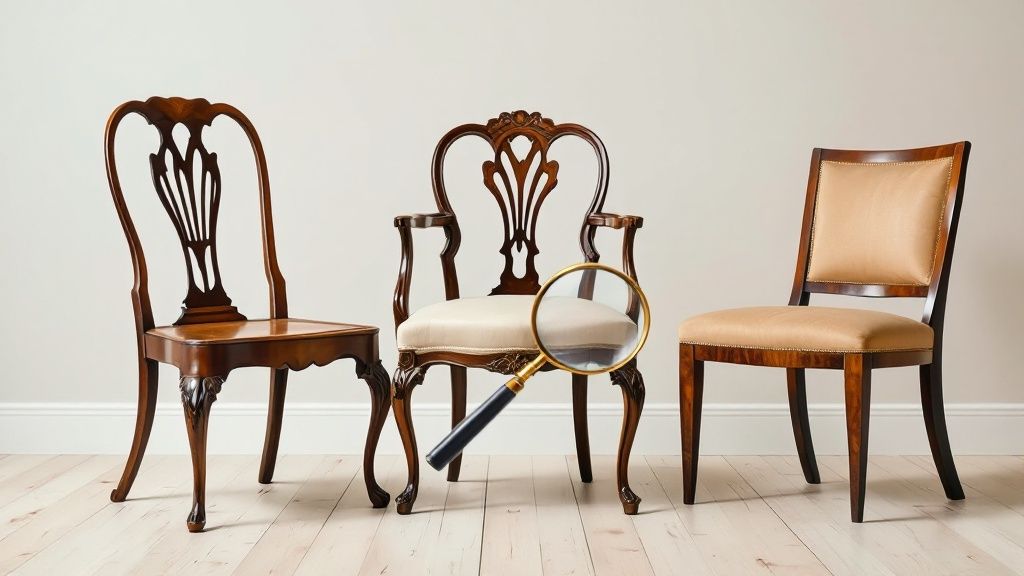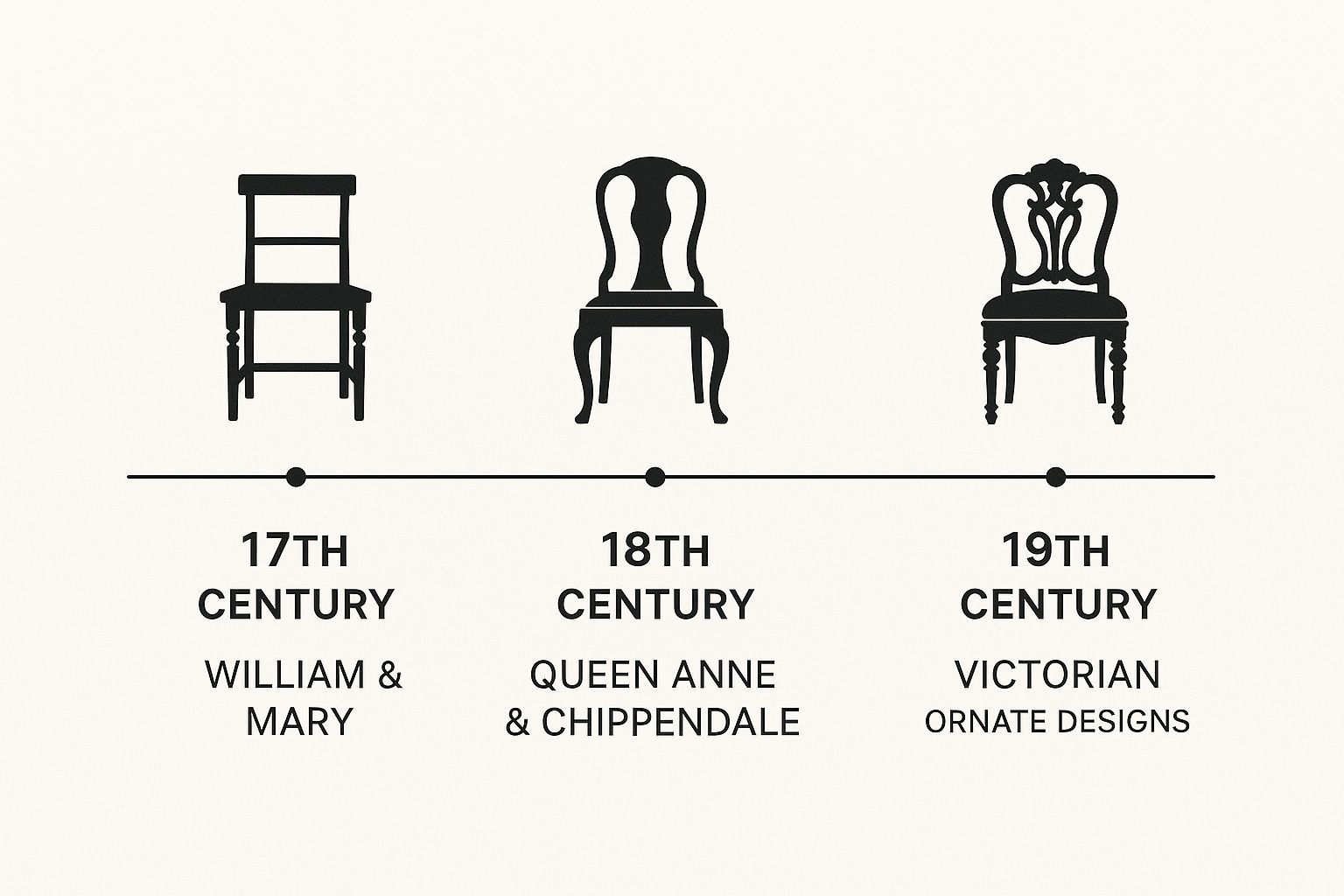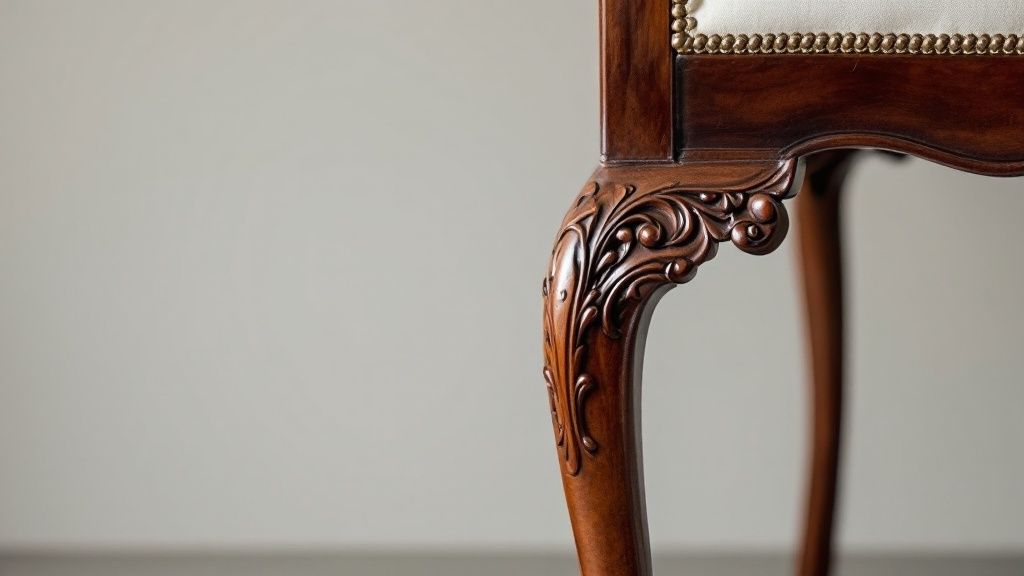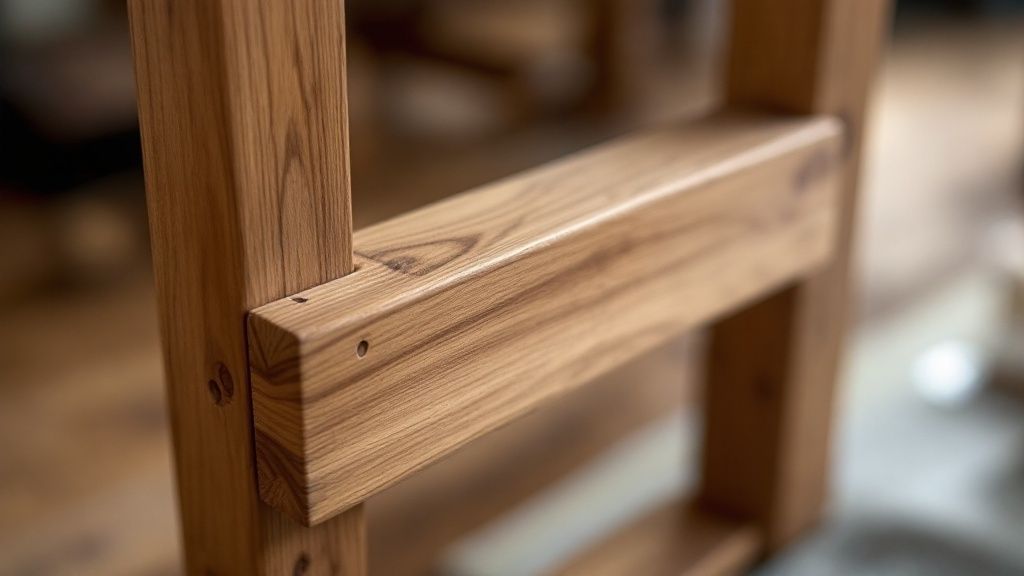How to Identify Vintage Furniture: Expert Tips
05.07.25

Antique chair identification is a fascinating exploration of design history. Understanding the evolution of styles helps pinpoint a chair’s era and enhances its appeal. The following timeline provides a visual guide to key periods and prominent chair styles:

As shown above, the 17th century witnessed the emergence of the William & Mary style. The 18th century introduced the graceful curves of Queen Anne and the intricate details of Chippendale. By the 19th century, Victorian design embraced elaborate ornamentation. This progression demonstrates how social and artistic movements shaped chair design. For example, the cabriole leg, a signature of Queen Anne chairs, conveys lightness and refinement, reflecting the era’s artistic preferences.
Let’s explore the specifics of some important antique chair styles. Each period boasts unique characteristics, offering valuable clues for accurate identification.
To better understand these distinctions, take a look at the table below:
A chronological overview of major chair styles and their distinctive features:
| Time Period | Style Name | Key Characteristics | Notable Examples |
|---|---|---|---|
| 1689-1702 | William & Mary | High backs, elaborately turned legs, Spanish and Portuguese influences | High-backed chairs with caned seats and intricate stretchers |
| 1702-1714 | Queen Anne | Cabriole legs, vase-shaped splats, emphasis on comfort and understated elegance | Wing chairs, splat-back dining chairs |
| 1740-1780 | Chippendale | Intricate carvings, ball-and-claw feet, influences from Gothic, Rococo, and Chinese design | Ribbon-back chairs, camel-back sofas |
| 1837-1901 | Victorian | Ornate carving, dark woods like mahogany and walnut, plush upholstery, often reflecting historical revival styles | Button-tufted furniture, chaise lounges |
This table summarizes the key features of each style, allowing for quick comparisons and easier identification. Notice how the styles progress from the more angular lines of William & Mary to the increasing ornamentation of the Victorian era.
For contemporary chair design inspiration, you might find this article on Dining Chairs in New Zealand interesting.
Understanding the value associated with different antique chair styles is crucial, particularly for collectors. Historical context and design elements play a significant role in determining a chair’s worth. For example, Queen Anne wing chairs are highly sought after. These chairs, originating in the 18th century, typically feature sloping arms and a high, upholstered back—a design that remains popular. Authentic Queen Anne wing chairs can fetch £10,000 or more, while well-made later copies typically range from £1,000 to £3,500.
You can learn more about antique chair valuation and explore various furniture styles for further research. This knowledge helps you appreciate the craftsmanship and historical context of these pieces. This guide empowers you to embark on your own antique chair identification journey, equipped with the understanding to appreciate the craftsmanship and history behind these treasured pieces.
Antique chair identification relies heavily on understanding the materials and construction methods used throughout history. Different eras favored specific woods and techniques, offering invaluable clues to a chair’s age and origin. For example, the rich mahogany often seen in Chippendale chairs points towards the mid-18th century, while the use of quarter-sawn oak suggests an Arts and Crafts origin from the late 19th and early 20th centuries. This section delves into how these details aid in accurate antique chair identification.
The type of wood used is a primary indicator of a chair’s age. Early American chairs frequently featured maple, cherry, or walnut, reflecting readily available local timbers. To properly identify chairs by era, understanding construction techniques is beneficial. For more information, see how cabinet construction methods have evolved. Later periods saw increased use of imported mahogany and rosewood, especially in more elaborate styles. Examining the wood’s grain, color, and patina provides essential clues. Additionally, understanding how wood ages, including the development of a patina over time, helps distinguish authentic antique chairs from recent reproductions.
The way different parts of a chair are joined reveals much about its construction date. Early furniture makers relied on hand-cut joinery techniques like dovetails, interlocking joints often seen in drawers. These dovetails, each unique and slightly irregular, are a hallmark of handcrafted furniture. However, the advent of machine production in the mid-19th century led to more uniform, machine-cut dovetails. This distinction is key in antique chair identification, helping differentiate between hand-crafted and machine-made pieces. A chair with perfectly symmetrical dovetails is unlikely to be a true antique.
The level of craftsmanship in a chair’s details offers further clues to its age. Hand-carved embellishments, common in earlier pieces, display subtle variations and irregularities, reflecting the artisan’s hand. Machine-made ornaments tend to be more uniform, lacking the unique character of hand-carving. This distinction is crucial in identifying authentic antique chairs. The human touch adds significant value and historical context. In recent years, there’s been a resurgence of interest in certain antique furniture, including chairs. Windsor chairs, known for their simplicity and functionality, have become popular, bridging traditional and modern design. These chairs have seen increased demand, particularly for those integrating vintage pieces into contemporary interiors.

Upholstery plays a significant role in antique chair identification. Early chairs often featured horsehair stuffing, a natural material providing firm support. Later periods saw the introduction of various other stuffing materials and fabrics. Examining the upholstery can reveal crucial clues about a chair’s age and authenticity. Identifying the specific fabric type, patterns, and construction methods helps narrow down the period of origin. You might be interested in exploring collections of antique chairs. Through careful examination of materials and construction, you gain a multi-dimensional understanding that transforms how you evaluate every antique chair.
Identifying antique chairs often involves a bit of detective work. One of the most rewarding aspects is uncovering makers’ marks, stamps, or labels. These small details can significantly impact a chair’s value and provide a direct link to its history. This antique chair identification guide will help you navigate the world of makers’ marks.
Makers’ marks can be elusive. They aren’t always prominently displayed. Knowing the common hiding spots increases your chances of discovery. Check these areas:
Distinguishing authentic marks from later additions is crucial for accurate antique chair identification. For example, a mark made with modern tools on a supposedly 18th-century chair is suspicious.
Recognizing the styles of prominent chair makers is a valuable skill. Here are a couple of examples:
While famous makers command higher prices, lesser-known regional craftsmen can be equally valuable. Local historical societies, antique guides, and online forums are valuable resources. Their pieces often represent excellent value. For example, a locally made chair might reflect regional cultural influences.

By carefully examining these “signature trails,” you can unlock a deeper understanding of your antique chair’s origins and enhance your appreciation for its craftsmanship. This knowledge transforms antique chair identification into a rewarding experience.

Developing a discerning eye is essential when identifying antique chairs. It’s crucial to learn the difference between authentic antiques, clever reproductions, and expertly concealed repairs. This careful evaluation will not only protect your investment but also build your reputation as a knowledgeable collector.
Authentic antique chairs will naturally display signs of age and use. This wear should align with the expected aging process over decades. For instance, armrests will often develop a smoother patina from years of contact with hands. The seat edges might also show some gentle wear from regular use. These subtle indicators are key elements of antique chair identification.
Reproductions and repairs often betray themselves through inconsistencies in materials and construction methods. Be sure to check for mismatched wood grains, the use of modern fasteners, or finishes that don’t match the chair’s supposed age. As an example, finding Phillips head screws on a chair claimed to be from the 18th century is a significant warning sign. These chronological inconsistencies are valuable clues during the identification process.
Even authentic antique chairs can be negatively impacted by improper restoration. Using the wrong materials or techniques for the period can significantly lower a chair’s value. Replacing original components with modern materials or using incorrect finishing methods will compromise its authenticity. Using a modern polyurethane finish on a Victorian chair, for example, is inappropriate and detracts from its historical significance. Always check for signs of over-restoration or the use of incorrect materials.
One of the most effective ways to improve your antique chair identification skills is through side-by-side comparisons. By comparing a potential antique with a verified authentic piece of the same style and period, you can identify subtle differences in construction, materials, and wear patterns. This method is especially helpful for spotting well-made reproductions that could fool even experienced collectors. Online resources and antique furniture books offer excellent images for comparison.
If you’re unsure about a chair’s authenticity, it’s always wise to seek expert advice. Consulting a reputable antique appraiser or a seasoned dealer can provide valuable insights. These professionals possess the knowledge and experience to identify subtle details that might be missed by an untrained eye. A professional assessment is incredibly valuable, especially when making significant investments in antique furniture. While learning the fundamentals of antique chair identification is important, a professional consultation provides added reassurance.
Not all antique chairs are created equal. Some become treasured heirlooms, appreciating in value over time, while others simply remain “old furniture.” This guide explores antique chair styles that consistently hold or increase their value, offering insights for collectors and those seeking furniture as an investment.
Certain chair styles remain perennial favorites among collectors, maintaining a steady market presence and often appreciating in value. Louis XVI chairs, with their neoclassical elegance and refined details, are a prime example. Their graceful lines, intricate carvings, and use of high-quality materials like mahogany make them highly desirable. Similarly, the simple yet beautifully crafted Shaker chairs, known for their honest construction and timeless appeal, consistently attract discerning buyers. For more inspiration, check out our guide on antique chair collections.
Several factors contribute to a chair’s investment potential. Provenance, or the documented history of ownership, can significantly impact value. A chair with a known history, especially if it belonged to a prominent figure, becomes more desirable. Condition also plays a crucial role. While some wear is expected, major damage or poor repairs diminish value. Sensitive restoration, however, using period-appropriate techniques and materials, can enhance a chair’s worth.
To help illustrate the value differences across various styles, let’s take a look at the following table. It provides a snapshot of the current market and potential investment opportunities.
| Chair Style | Period | Current Demand | Approximate Value Range | Investment Potential |
|---|---|---|---|---|
| Louis XVI Chair | 1774-1792 | High | $1,000 – $10,000+ | Excellent |
| Shaker Chair | 18th-19th Century | Steady | $500 – $5,000+ | Good |
| Victorian Eastlake | Late 19th Century | Moderate | $300 – $2,000 | Moderate |
| Art Deco Chair | 1920s-1930s | Increasing | $500 – $3,000+ | High |
| Mid-Century Modern | 1940s-1970s | High | $200 – $5,000+ | Excellent |
As the table shows, certain styles like Louis XVI and Mid-Century Modern consistently command higher prices and demonstrate excellent investment potential due to their enduring popularity. Other styles, while perhaps less expensive, still offer promising returns for savvy collectors.
Regional preferences and evolving interior design trends also influence a chair’s desirability. For instance, certain regional styles, like Pennsylvania Dutch painted furniture, may be more highly valued in areas with those cultural traditions. Shifting design trends also play a role. The recent resurgence of mid-century modern furniture, for example, has significantly boosted the value of chairs from that era.
Identifying undervalued chairs requires careful observation. Look for pieces with solid construction, high-quality materials, and desirable stylistic elements. A Victorian chair with original upholstery and intricate hand-carving, even if needing minor repairs, could be an excellent investment opportunity. Restoration costs can be far less than the increase in value after the work is complete.
Staying informed about emerging collector trends offers a significant advantage. Previously overlooked styles, like Art Deco chairs with their geometric lines and bold designs, are gaining traction among serious collectors. Recognizing these trends allows for smart acquisitions before prices rise. Understanding the nuances of specific makers or regional styles can also help uncover hidden gems.
Developing the ability to distinguish exceptional pieces from ordinary ones is key to building a valuable collection. This involves examining materials, construction techniques, and stylistic details. Learning to recognize the subtle differences between hand-carving and machine-made ornamentation, for example, can significantly impact your ability to assess value. Cultivating your knowledge of antique chair identification allows confident navigation of the market and informed decisions, whether you’re collecting or simply enhancing your home.
Knowing the value of antique chairs is crucial for both collectors and sellers. It replaces guesswork with assurance, enabling you to make smart choices about your furniture. This guide will walk you through the methods professionals use, from respected auction houses to experienced insurance appraisers.
Appraising an antique chair relies on four key elements: provenance, condition, rarity, and historical significance. These interconnected factors work together to determine market value. Let’s delve into each one.
Restoration decisions can dramatically affect a chair’s value. Careful restoration using appropriate techniques and materials can increase its worth. Conversely, improper restoration can decrease it. Using modern replacements or incorrect finishes can severely lower the value for serious collectors. Think of it like restoring a vintage car: modern parts might work, but they detract from its authenticity and value.
Several resources can help you determine a chair’s value. Online auction databases, such as LiveAuctioneers, offer insights into recent sale prices of similar chairs. Price guides can give general value ranges for different styles and periods. Joining online communities of collectors can offer valuable insights into market trends.
Understanding valuation prepares you for successful negotiation. You’ll be able to identify undervalued pieces and justify the value of your own chairs. This knowledge facilitates confident decision-making, both when buying and selling.
By mastering these principles and using the resources available, you’ll develop the expertise to assess antique chairs confidently. This knowledge transforms buying and selling from a risky venture into a well-informed process.
Ready to discover exquisite antique chairs and elevate your home with timeless elegance? Explore our curated collection at High End Used Furniture today. We offer a wide selection of meticulously inspected pieces, from traditional to contemporary, to fit any style and budget. Let us help you find the perfect antique chair to enhance your living space.
High end used furniture